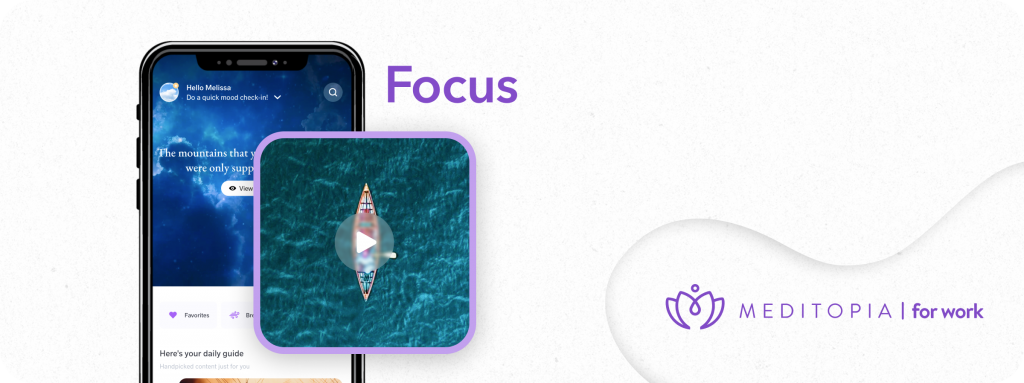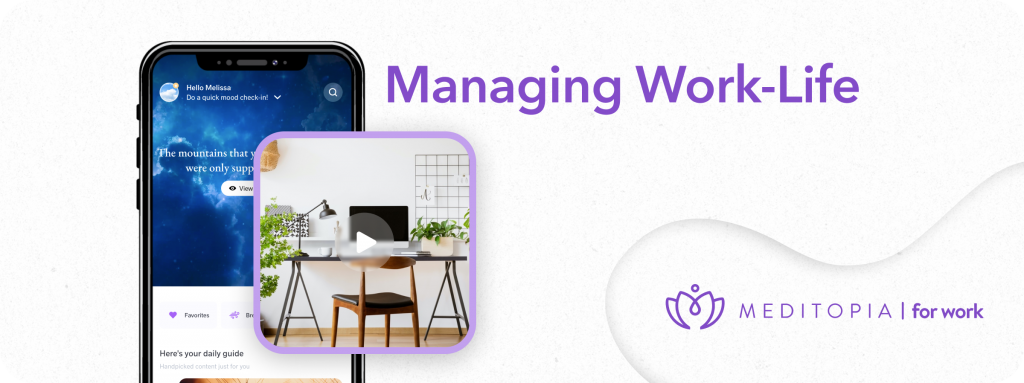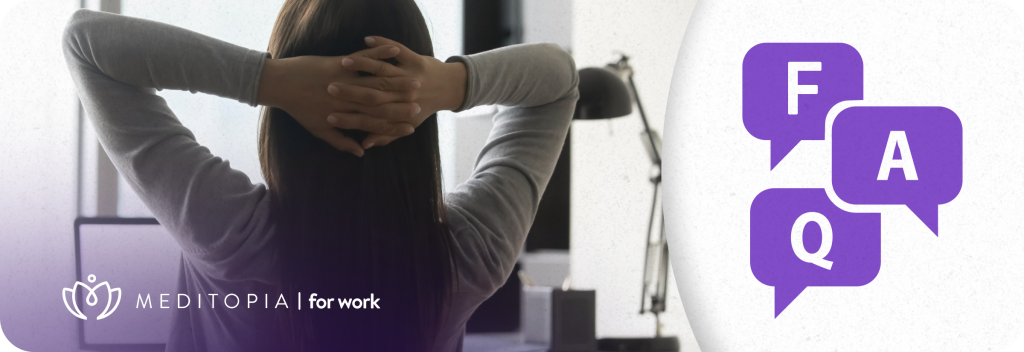Mindfulness for Companies: Bringing Mindfulness to the Workplace


Many employees view work as a process to be endured, anticipating better days ahead. When this perspective is internalized, it can prevent employees from living life to the fullest. Incorporating mindfulness at work and fostering a culture of mindfulness in the workplace can significantly enhance employee well-being, engagement, and mental health. Let’s discover how.
Why Bring Mindfulness to Work?
It is important for HR and people managers to bring mindfulness to the workplace because it enhances overall employee well-being, productivity, and job satisfaction. More precisely, mindfulness at work reduces stress, improves focus, and fosters better emotional regulation.
A study by Aetna found that employees who participated in corporate mindfulness programs reported a 28% reduction in stress levels and a 20% improvement in sleep quality. This led to increased productivity and reduced healthcare costs.
Mindfulness for business also promotes a positive work culture. Take Google’s “Search Inside Yourself” program as an example, this initiative teaches employees mindfulness practices to enhance emotional intelligence and leadership skills, resulting in a more engaged and resilient workforce.
Real-Word Examples of Mindfulness in The Workplace

- This article from the Cambridge University Press Public Health Emergency Collection provides an illuminating distinction between mindfulness and meditation. Author C. Behan notes that “meditation usually refers to a formal practice that can calm the mind and enhance awareness of ourselves, our minds and our environment,” whereas mindfulness, “means being aware of the present moment.”
While the terms are inevitably linked, Behan goes on to detail how such practices can reduce stress and anxiety through crises like the pandemic, including a host of sources indicating a positive correlation between meditation and stress relief. Particularly interesting is the idea that mindfulness has become more accessible as we’ve seen an uptick in apps providing guided meditation. - Forbes Council Member Laura Sage writes about six proven benefits of meditation in the workplace in this article. Sage discusses how meditation can reduce prejudice, improve cognition, counteract stress, foster collaboration, boost memory, and curb emotional reactions.
Beyond those benefits, Sage suggests that integrating meditation into corporate culture doesn’t mean that “you have to really work at it over a long period of time,” but rather you can start small, beginning with, “meditating for 1-3 minutes once a day,” or even “incorporating a 90-second meditation to begin or end a meeting,” to frame the conversation. - In this Harvard Business Review article, Matthias Birk discusses three strategies for proactively navigating difficult emotions in the workplace. From feeling our emotions to reframing the narrative around them to just expressing them, Birk suggests that mindfulness is an effective vessel through which to process global crises or major events/changes.
We so often compartmentalize, isolating the emotional experience from our work life, but mindfulness can not only deepen our self-awareness of those very feelings but also enrich our connection to those we work with and our careers themselves.
Benefits of Mindfulness For Employees
Mindfulness is about being in the present moment rather than controlling emotions. More specifically, mindfulness in the workplace aims at connecting people’s minds and bodies to focus, feel more confident, improve cognitive performance, and reduce stress. But what else could this practice do for your teams’ well-being and company culture?
Managing Employees Stress
A study conducted at Uludağ University showed that people who regularly practice mindfulness exercises, such as yoga and meditation, reduce their stress levels, often have higher-paying jobs, and greater life satisfaction compared to those who do not. Another study with academics found that increased mindfulness practices correlated with higher happiness, team collaboration, and better stress-coping strategies.
In light of these findings, taking a break during a busy or stressful workday to practice mindfulness can significantly impact well-being and engagement. Starting with some relaxing breathing techniques is an excellent way to introduce mindfulness in the workplace.
If you wish to support your team’s mental health and develop a more positive work culture, check Meditopia’s app and its 1000+ meditations, breathing exercises, sleep stories, and more.
Increasing Your Employees Psychological Resilience
We’ve all had bad days at work, and these challenging moments can be even more impactful when employees are already stressed in their personal lives. Recognizing that these feelings are temporary and creating space to build mental resilience is essential, and mindfulness at work can help them achieve that. In fact, a study shows that a workplace mindfulness intervention improves psychological well-being and productivity.
At first, it may be challenging for employees to believe that stress is temporary and to accept intense and difficult situations as they are. However, through regular mindful practices such as observing their body and thoughts without judgment, employees can develop this acceptance and patience.
This approach not only enhances team collaboration and individual well-being but also fosters a more resilient and engaged workforce.
Managing Employee Feelings of Inadequacy
One of the most prevalent feelings employees may face in their work lives is inadequacy. From a young age, many individuals set goals, overcome obstacles, and strive to progress. This drive for efficiency and success often becomes a critical criterion in adulthood, making it difficult for employees to accept themselves as they are.
As HR professionals and managers, it can be challenging to know what to do to support employees’ mental health, but sometimes the best initial alternative is to be there and listen. You can help employees remember that they are worthy and deserve to feel good, regardless of their achievements.
That’s why encouraging mindfulness at work can help your team find a safe space to acknowledge their worth when feelings of inadequacy arise.
Enabling Employees to Rest
Not noticing when your team needs a break could have negative consequences for their productivity, engagement, and well-being. This delay in addressing the need for rest can lead to drained energy and ignored basic physiological needs like drinking water, moving their bodies, or even taking bathroom breaks. When these needs are unmet, employees may become passive-aggressive or nervous, reacting differently than they would otherwise.
Team mindfulness practices can help employees identify and address their needs by encouraging regular self-check-ins. Taking brief breaks to fulfill both physical and mental needs can significantly reduce stress and irritability. Encourage this whenever possible.
Meditopia’s app helps you to avoid this by sending notifications with mindfulness content they can consume to reduce stress and avoid burnout on time.
Establishing Boundaries
Being aware of personal boundaries is crucial for creating space for rest. Moreover, balancing work and personal life can be challenging, especially for those working from home. Research shows positive relationships between mindfulness and work/life balance, as well as between mindfulness and job performance.
This other research, for instance, indicates that workplace mindfulness is positively correlated with job performance and negatively correlated with turnover rates.
In other words, the more mindfulness employees practice, the better their performance and the lower the turnover rate. And one last thing: Your boundaries as a leader or manager also matter. Recognize when you need a break, and find support in your network to get it. That’s what mindfulness for managers is for.
Increasing Employees Attention
Curious about how corporate mindfulness can increase employee attention? It’s all about the connection between the environment, mind, and body. Focus-themed meditations, for example, help the person enter a state of relaxation, helping the brain to focus by reducing overthinking, stress, and worries.
On the other hand, focus music and natural sounds mask external noises and the subtle audio waves help the employee concentrate on the task they are working on. The same occurs when they practice breathing exercises.
This article examining the concept of mindfulness compiled findings showing that mindfulness contributes to focus, emotional regulation and intelligence, job performance, and constructive conflict resolution processes. Based on these results, mindfulness practices open the door to possibilities for happier, more productive, and creative business lives.
Steps for Authentic Workplace Community Through Mindfulness
Let’s take a look at five steps Sydney McQuade, Licensed Professional Counselor of US-based Counterbalance Counseling, suggests you can take to build a more authentic community within your workplace based on safety, honesty, and radical acceptance.
- Positive reframing over character defamation. Focus less on the person who made a mistake and more on the actions or behaviors themselves. People are complex, after all, and cannot be fixed or summed up in one moment.
- Praise for hard work over aptitude. Acknowledge and celebrate the work that people have put in. Even if that means that they haven’t yet met or exceeded a particular goal. Being seen for our efforts throughout a process can have a powerful motivational effect.
- Deliver difficult feedback with tact and care. We want to be able to hold each other accountable without sacrificing our humanity. When that trust and care are established, it’s much easier to take in that feedback and move forward with purpose.
- Push people to do their best, while offering tons of support. Pushing people relentlessly without offering additional assistance can feel isolating. Encourage everyone to do their best, while also accepting the fact that that can look different for everyone.
Workplace Mindfulness Meditations for Beginners
Meditopia has different programs for different levels of practitioners and to build mindful leadership. The goal is to make mindfulness for work accessible for everyone, independently if they have tried it in the past or not. These are some of the programs we offer, and how they can help your team live a mindful work life.
Foundations

This meditation program serves as an introduction to some of the foundational techniques found in meditation, focusing on your body and breath. Never tried meditation before? This is the program for you.
A great way to begin integrating mindfulness into your company’s culture is to experience a program together. Try starting with this one, which provides ten sessions ranging from just eight to 14-minute long meditations.
Focus

Maybe you’ve identified an individual or collective struggle with focus at work. This seven-session program allows you to improve your ability to focus while staying fully present
If you’re noticing that whole-company mindfulness isn’t as easy to manage or the logistics are too tricky to iron out, this can be a great series to try with the buddy system. Maybe each pair tries one meditation a week and meets to reflect on its impact.
Managing Work-Life

Let’s say mindfulness is a well-established practice at your company. This series is a great refresh that can open up the conversation about work-life balance and how to improve its current state as you reflect on the series together. It’s a great team mindfulness exercise.
Company-Branded Playlists

With Meditopia, you can handpick meditations, sleep stories, songs, and talks to meet the exact needs of your colleagues. Beyond that, you can even create specific playlists for different teams within your organization for weekends, holidays, or just a general company favorites list.
Again, finding what works for you and your employees is going to look different for each company. The important thing is to start a foundation of company culture based on trust and continue building from there.
How to Implement Mindfulness in The Workplace?
Are you inspired to start your own mindfulness at work program? Great! Let’s now discover simple yet efficient steps for you to start as soon as possible.
| Steps | Description | Benefits |
| Start Small | Begin with short, daily mindfulness exercises. | Builds a habit without overwhelming employees. |
| Establish Mindfulness Programs | Create structured programs with workshops and meditation sessions. | Enhances stress reduction and resilience. |
| Encourage Regular Breaks | Promote stepping away from desks for mindful activities. | Improves focus and reduces stress. |
| Provide Resources | Offer access to books, apps, and online courses on mindfulness. | Increases knowledge and practice of mindfulness. |
| Lead by Example | HR and managers openly participate in mindfulness practices. | Sets a positive tone and encourages adoption. |
| Create Designated Spaces for Mindfulness | Dedicate quiet, comfortable areas for mindfulness activities. | Encourages regular mindful breaks. |
Start Small
Begin with short, daily mindfulness exercises such as deep breathing or a five-minute meditation. Gradually increase the duration and complexity of these practices. You can find more than 1000 in Meditopia’s app.
Establishing Mindfulness Programs
Consider creating structured mindfulness programs tailored to your workplace needs. This can include offering regular mindfulness workshops, meditation sessions, and training programs. For example, you can partner with mindfulness experts to provide sessions on stress reduction, emotional intelligence, and resilience.
Encourage Regular Breaks
Promote regular breaks throughout the workday for mindfulness activities. Encourage employees to step away from their desks, stretch, and practice mindful breathing. You can even create a “Mindful Break Schedule” where each team gets to participate in different mindfulness practices for 10 minutes a day.
Provide Resources
Offer access to mindfulness resources for work such as books, apps, and online courses. Consider creating a mindfulness library or resource center where employees can learn more about mindfulness practices. You can also schedule webinars and workshops so your team can get new skills to improve their mental health.
Leading by Example
When leaders openly participate in mindfulness activities, it sets a positive tone and encourages employees to follow suit. Share your experiences with mindfulness practices, highlight their benefits, and make a point to practice mindfulness during meetings or stressful situations.
Creating Designated Spaces for Mindfulness Activities
Whenever possible, dedicate quiet, comfortable spaces where employees can practice mindfulness activities such as meditation, deep breathing exercises, or reflection. These spaces should be free from distractions and equipped with comfortable seating, soft lighting, and calming décor.
Key Takeaways
- Mindfulness at work significantly reduces stress levels and improves overall mental health.
- Regular mindful practices can lead to better attention spans, resulting in more productive and higher-quality work output.
- By encouraging mindfulness, HR and managers can cultivate mindful leadership, a culture of empathy, collaboration, and mutual respect among employees.
- Starting with small, daily mindfulness exercises and creating dedicated spaces for practice makes it easy to integrate mindfulness into the workplace.
Mindfulness for Companies: Bringing Mindfulness to the Workplace – FAQS

How can mindfulness improve employee well-being and mental health?
Mindfulness at work reduces stress and enhances emotional regulation, leading to better mental health. It also promotes a sense of calm and well-being among employees.
How can mindfulness enhance workplace productivity and focus?
Mindfulness practices help employees maintain better focus and attention, increasing productivity. By reducing distractions and stress, employees can work more efficiently.
What challenges might arise when integrating mindfulness into a corporate culture?
Resistance to change and skepticism about the benefits of mindfulness at work can be significant challenges. Additionally, finding time for mindful practices in busy schedules may be difficult.
Are there any specific industries or types of workplaces where mindfulness is particularly beneficial?
Mindfulness is particularly beneficial in high-stress industries like healthcare, finance, and tech, where employees face intense workloads and high-pressure environments. However, it can enhance well-being and performance in any workplace.
How can organizations measure the impact of mindfulness programs on employee performance and satisfaction?
Organizations can measure the impact of mindfulness programs through employee surveys, performance metrics, and reduced turnover rates. Tracking improvements in well-being, engagement, and mental health can also indicate program success.






Cambiaron los accesos a la aplicación . Es muy complejo infresar
¡Hola Natalia! Para apoyarte con cuestiones técnicas por favor escríbenos a [email protected], estamos para ayudarte. ¡Que estés muy bien!